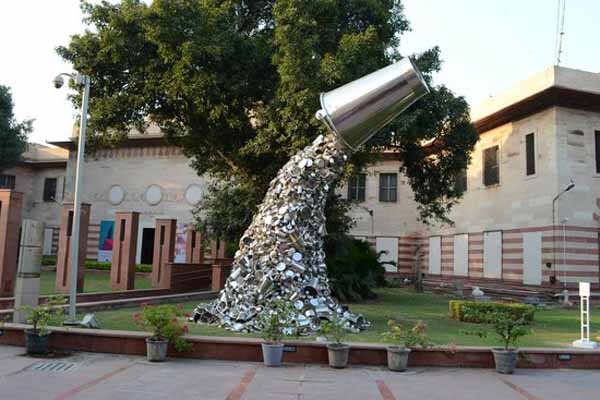The National Gallery of Modern Art (NGMA) will exhibit the artwork of eminent Indian artist Shri A. Ramachandran. This exhibition is supported by the Vadehra Art Gallery, New Delhi. The exhibition is conceptualized by R. Siva Kumar and presents over 260 works of the artist done between 1968 and 2019 and includes mural-size paintings, sculptural installations and the single piece works, etchings, watercolors, drawings and illustrated books.
The exhibition will be inaugurated on the 26th of April, 2019 at 5.00 pm in the gracious presence of Director General, NGMA Shri Adwaita Charan Garanayak. It will remain open till the 12th June 2019. Visting hours are from 11:00 am to 6:00 pm, on weekdays and 11:00 am to 8:00 pm on Saturdays and Sundays.
Ramachandran’s career can be divided into two broad periods, each with its distinctive subject matter and style. His works from the first period, covering 20 years from the early 60s to the early 80s, are a passionate response to the social violence he witnessed in post-partition India and across the world post-world war II. The works from this period are generally large, mural sized, socially engaging, seething with righteous indignation. This phase of his work is represented in this exhibition by a set of etchings based on biblical subject matter but actually commenting on the plight of the marginalised in urban Delhi.
In his paintings, Ramachandran also makes a strong case for contemporary art informed by indigenous traditions.
Yayati, a 60 feet three part mural on canvas completed in 1986 marks the beginning of the second period. If works of the first period were brooding, pessimistic and motivated by anger and hopelessness, works of the second period are colourful, exuberant and celebrate life and nature. This change of vision and style were not brought about by a sense of social resolution but by the realisation that the power of art to bring about real changes in the world is indeed limited, and urban modern artists, including himself, have turned a blind eye to everything that brought beauty and meaning to life in pre-modern societies. Since the 80s, Ramachandran has built his work around village life and nature around Udaipur.
Backgrounder
On first view, these works might appear exotic and romantic to the urban viewer who have all but forgotten about non-urban communities and life lived in communion with nature. But on closer inspection it becomes amply evident that Ramachandran looks at his subjects not through the eyes of a cultural tourist but as someone who has re-discovered life lived according to alternate values where violence and strife has little place. Some of these works are documentary, some are imaginative expressions of empathy, and some, especially the landscapes, are expressions of deep experience. In these paintings, Ramachandran also makes a strong case for contemporary art informed by indigenous traditions. Born in Kerala in 1935, Ramachandra turned to art after completing an MA in Malayalam literature in 1957. He studied art at Santiniketan (1957-1961) under Ramkinkar Baij, who he thought came close to ideals of the progressive writers he greatly admired. After completing his studies at Santiniketan he moved to Delhi in 1964 and began to teach at the Jamia Millia Islamia University in 1965, and taught there until he took voluntary retirement in 1992. He received the national award in 1969 and 1972, and the Noma Award from Japan for children’s illustration in 1978 and 1980. He was elected Fellow of the Lalit Kala Akademi in 2002, honoured by the Raja Ravi Varma Award in 2003 and the Padma Bushan in 2005.
In the same year he was made Professor Emeritus, and was awarded the Kalidas Samman in 2018. Although he began his career as a modernist painter, over the years Ramachandran enlarged his repertoire to include sculpture, prints, and designing. This exhibition provides glimpses of this versatility.
National Gallery of Modern Art, Mumbai
The idea of establishing the National Gallery of Modern Art (NGMA) was mooted immediately after India became independent. The first NGMA was opened on March 29, 1954 in the National Capital – New Delhi- at the historic Jaipur House, one of the premier architectural edifices of Lutyens’ Delhi, by the Vice-president, Dr. S. Radhakrishanan, in the presence of Prime Minister Jawaharlal Nehru and artists and art lovers of the city. The NGMA is a repository of the cultural ethos of the country and showcases the changing art forms in the field of Visual and Plastic arts through the passage of the last 160 years starting from about 1857. NGMA is run and administered as a subordinate office of the Ministry of Culture, Government of India; it has two branches – one at Mumbai and the other at Bengaluru.
The National Gallery of Modern Art, Mumbai was opened to the public in the year 1996. It is located in the precincts of the former auditorium the Sir Cowasji Jehangir Public Hall and the Institute of Science. This architecturally marvelous building was designed and built by the famous British architect George Wittet. Subsequently, this building has been completely redesigned by the famous architect Shri Romi Khosla giving it a spiral spin. It hosts various national and international exhibitions. It has its own art collection comprising paintings, sculpture, and graphics, with a focus on Indian and International artists, mainly from the progressive art group like K.H. Ara, F. N. Souza, V.S. Gaitonde, S.H. Raza and M. F. Hussain.
NGMA, Mumbai has had a great tradition of hosting several spectacular exhibitions in the past, which we are continuing to date. Some of the recent exhibitions include the highly successful Bombay Art Society exhibition, which covered the landscape of the historic Bombay Art Society’s existence over 125 years. NGMA, Mumbai has also hosted several other notable exhibitions which include Rabindranath Tagore, Amrita Sher-Gil, Jamini Roy, Nicholas Roerich, the Parsi exhibition and major exhibitions on A. A. Almelkar and M. V. Dhurandhar.


